For a garden virtually unattended and sparsely watered, Alan Hackler’s front yard looks surprisingly alive.
Gnarled Toyon, flowering Manzanita, wild iris, buckwheat, gooseberries and sprays of deerbrush flank the path to his single-story cottage, a few-minutes walk from San Jose’s City Hall. Apple-hued yerba buena—a type of native California spearmint—and pine-green leaves of beach strawberries and yarrow spread into plush groundcover.
“When I moved here, this was all dirt,” says the 34-year-old Hackler, brown curls tumbling out of a trucker hat on a sunny-day tour of what he calls his wild garden. “Junk-littered dirt.”
By landscaping with strictly indigenous plants, Hackler manages to keep water use to a minimum. What little he does tap comes from a 200-gallon rainwater tank that, by way of a spigot or an overflow pipe, tumbles into a dry creek and percolates into the soil. Even his chickens have a rain barrel.
Out back, he’s installed a system of subterranean pipes that pump dirty sink, shower and laundry water—commonly called graywater—to the roots of fig, apple, kiwi and lemon seedlings.
With California slogging through its fourth year of an apocalyptic dry spell—the worst in 106 years—Hackler’s knack for creating drought-tolerant landscapes is in high demand. Since founding Bay Maples Wild Gardens in 2007, the Silicon Valley native has transformed more than 200 properties to require little to no irrigation.
“People are realizing that it doesn’t make sense for our climate to keep watering these huge green lawns,” he says. “I think in the next couple of years, we’re going to see a shift in how our communities look. More native plants, less and less turf.”
As a conservation evangelist, Hackler often has to persuade clients to overcome an oddly nostalgic attachment to their grass lawns—heralded now as California’s great suburban water-suck. They’re convinced, he says, that their child’s happiness depends on green grass, that it’s somehow a requisite of a well kept home.
“People cherish their lawn,” agrees Santa Clara Valley Water District spokesman Marty Grimes. “They’ve had it forever. But we’re adjusting to a whole new reality where California doesn’t have enough water to sustain that anymore. That’s hard for some people to cope with.”
So it becomes part of Hackler’s job, and the water district’s, to convince people that California-appropriate landscapes can be more attractive than same-old turf—to change the collective preference.
“As much as we love a nice green lawn, it’s not natural for California,” Grimes says. “Just look around at the way the wild landscape changes season-to-season: green grass in the winter and brown dry brush in the summer.”
If not for aesthetic reasons, there’s plenty of financial incentive to make the switch. Since Gov. Jerry Brown ordered a 25 percent cut in statewide urban water use at the start of April, many of the state’s 400-plus local water districts have upped the budget for turf-removal rebates.
The Santa Clara Valley Water District has an especially strong impetus to change habits after missing its water reduction goals—public consumption fell by just 13 percent in 2014, while the goal was 20 percent. With South Bay reservoirs only half full and groundwater levels 40 feet below average, local jurisdictions have now gone beyond the governor’s mandate and called for a 30 percent cutback in water use.
The Santa Clara Valley Water District increased its lawn-replacement rebate fund more than nine-fold in the past few years, from $700,000 in 2011 to $6.5 million this fiscal year. That evens out to $2 per square foot, with a $50,000-per-site cap. In 2013, the district serving 1.8 million customers replaced 160,000 square feet of lawns with drought-abiding permaculture. It flipped 1.1 million square feet the following year. Through the end of April this year, the district already doled out rebates for 1.28 million square feet.
While some people opt to maintain the illusion of green lawns by spray-painting dead grass or installing artificial turf, Hackler says they’re missing the point. “People want grass and they don’t know why,” he says. “The fact is we’re going to have to permanently change our ideas about what our urban environment should look like.”
Farms drink up some 40 percent of California’s water, according to the California Department of Water Resources, and about half goes to lakes, rivers and natural waterways. Cities and towns take up just 10 of the state’s water supply. Still, water wonks say that easing up on irrigation is one of the most effective ways for individual consumers to contribute to the greater conservation effort.
“We have control over our immediate surroundings,” Hackler says. “That’s a start.”
Operating under the assumption that the drought signals a long-term shift because of climate change, not just a particularly punishing barren stretch, water officials are moving forward with plans to build permanent water-saving infrastructure. Just over a month ago, San Jose Mayor Sam Liccardo guzzled a beaker of treated sewage at staged event to drum up publicity for a planned $800 million expansion of local “toilet to tap” water recycling. Near San Diego, a $1 billion desalination plant is on track to deliver up to 50 million gallons of drinkable water a day by this fall.
But a study released last week underscored the importance of low-tech conservation in addition to high-tech infrastructure. Researchers from the University of California, Irvine, looked at how Melbourne survived a 13-year drought.
By the end of the drought in 2009, the Australian city of 4.3 million had cut its water consumption in half, largely through low-cost solutions like rainwater tanks, water-efficient toilets, showerheads and washing machines and capturing storm water runoff. Construction of a $6 billion desalination plant was completed three years after the drought’s end, though the facility has yet to wring out a single drop.
“One lesson for other cities is that major droughts, if serious enough and long-lasting enough, create opportunity for policymakers,” the study states, “as well as pose challenges.”
One such challenge is how to rein in the general public’s water use with a balance of rationing, fines and, eventually, reflecting its scarcity by upping the price point.
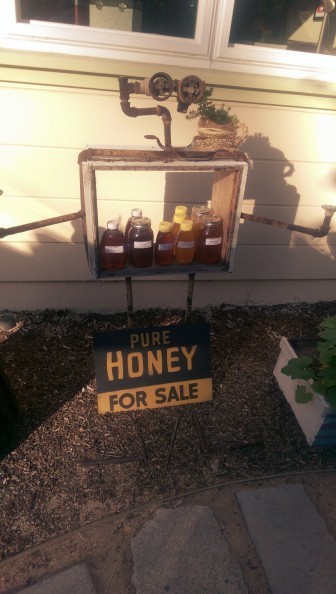
A honey stand fashioned from repurposed irrigation pipes and an old beehive.
Craig Heikem let his lawn die long before public officials handed down any water-saving mandates.
“We watered it at first,” says Heikem, who moved with wife and kids into his Willow Glen home in 2007, four years ahead of the drought. “But we never felt good about it, so we just stopped. Let it turn brown.”
A few years ago while volunteering at his kids’ elementary school, he met Hackler planting an Ohlone garden of native plants and asked him to revamp his bone-dry yard. The resulting landscape has become a gathering space for the neighborhood. A path puzzle-pieced together with urbanite wends past rosemary and sage brush, a native grapevine and a couple artfully placed succulents.
By the front porch, a robot-looking gizmo made of old metal irrigation pipes and a beehive box holding jars of varicolored honey from Heikem’s backyard bees. Neighbors can take it as needed on the honor system, he says. Hackler has a talent for upcycling scraps into decks, trellises, sculptures or other accents. The rusted pipes forming the honey stand were dug up from Heikem’s dead lawn. Stumps bordering parts of the garden were salvaged from an arborist.
“The whole yard’s become a conversation piece,” says Heikem, who lists his address as part of a series of native garden tours. “When you have a lawn, it feels untouchable. People yell at you if your dog pees on it. … But with this, kids walking with their parents will take a detour to run through the path, jump off the rocks and hide in the bushes. It’s gotten me closer to my neighbors.”
Bay Maples will celebrate the grand opening of its new location at 1231 N. First St., in San Jose, from 6-10pm June 13. The event will feature workshops, local artists and live music.
- A 200-gallon rain tank supplies water to Alan Hackler’s native garden. (Photo by Greg Ramar)
- Modular tanks collect rainwater from the gutters. (Photo by Greg Ramar)
- A little library stationed outside Alan Hackler’s garden on East St. John Street in San Jose. (Photo by Greg Ramar)
- Alan Hackler and his Rhode Island red. (Photo by Greg Ramar)
- Alan Hackler founded Bay Maples Wild Gardens in 2007 while studying environmental science at San Jose State University. (Photo by Greg Ramar)
- Salvaged lawn borders were repurposed into a walkway outside Alan Hackler’s San Jose home. (Photo by Greg Ramar)
- Alan Hackler shows where the water from his graywater recycling system pipes into his backyard garden. (Photo by Greg Ramar)
- Alan Hackler has responded to the drought by building a sustainable landscape at his downtown San Jose home. (Photo by Greg Ramar)

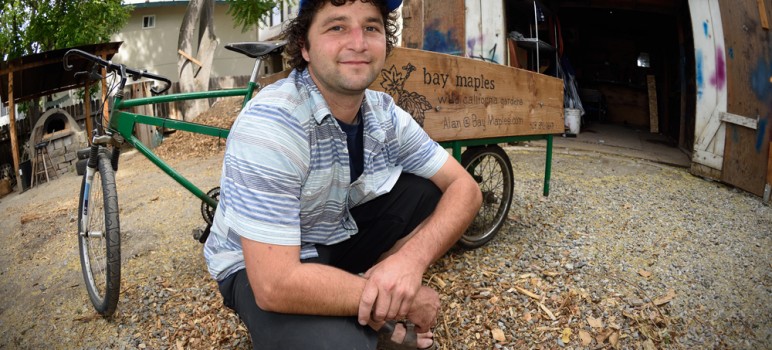
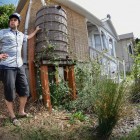
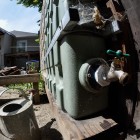
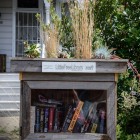

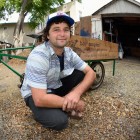
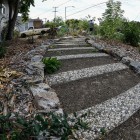
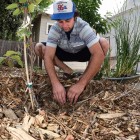
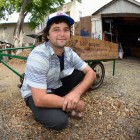
I got to thinking about what might be causing the California drought and started looking at historic California droughts,, not like doing research, I’m just a regular guy without a lot of education,, I was sitting at my computer one day with nothing to do,, I read an article about the California drought causing the land to buckle, then found a website with an archive of drought maps for the US (link below),, so I looked at them for a few hours and stumbled onto something that might be important,,
at first I thought it was simply the time of year when California droughts started and ended, like it was a seasonal thing,, later I found out that California enforces changes pollution standards at the first of the year, which appears to be when these drought occurrences begin and or end,, I also found accepted science, in fact by the top climate scientists in the world, talking about, not global warming or climate change, but something they say can be easily managed, which is changes in weather patterns caused by methane, and VOC’s that lead to low level ozone formation,, in fact they say it can be cost effective because these same pollutants also cause damage to crops and hundreds of billions of dollars worth of health care costs, which would be saved if we better regulated these VOC’s
what I discovered was that this drought began when California initiated its low carbon fuel standard on the first of the year in 2014,, I also found an expert analysis that claimed part of this LCFS strategy would increase VOC emissions while mentioning ethanol added to gasoline as one source,, so I looked closer at ethanol to find that when California changed the amount of ethanol added to gasoline from around 5% to 10% at the first of the year in 2010, the drought occurring at that time began to end,, so I looked back as far as the archive maps go to find other droughts beginning and ending around the first of the year,,
I think there is something there but I’m not smart enough to put it together
http://droughtmonitor.unl.edu/MapsAndData/MapArchive.aspx
Bobby:
> what I discovered was that this drought began when California initiated its low carbon fuel standard on the first of the year in 2014,,
I commend you on your scientific curiosity but I can’t accept your theory.
You have been snared by the logical fallacy known as “Post hoc ergo propter hoc” (After which, therefore, because of.)
Just because action B occurs after action A, it does not prove that action A CAUSED action B.
Nonetheless, there is an important point to be derived from your analysis:
Mankind (and maybe even womankind, for that matter) does NOT have the control over the natural environment that it imagine it has.
Probably nothing that humanity has done has caused the California drought. It’s just Mother Nature.
Climate changes — BY ITSELF! Weather varies from year to year, and from day to day.
There is virtually nothing that humanity can do to change the climate or the weather.
There is a HUGE danger in humanity trying stupid things to change the climate and screwing things up really badly.
There have been all sorts of proposals — some semi-serious, most just wacky — to “modify” the climate and solve the problem of [coming ice ages/global warming/holes in the ozone/you name it]:
irradiating the ionosphere with microwave energy (HAARP);
dispersing barium particles in the stratosphere (“chemtrails”);
dumping iron files in the oceans to stimulate algae growth;
spreading reflective particles into low earth orbit to provide shade from solar radiation’
etc. etc. etc.
All of these are THEORIES and no one knows if they will work or how well they will work.
What if some genius scientist convinces the U.N. and fear mongering, vote grubbing politicians to launch particles into space to lower the earths temperature by one degree.
But what if the scheme lowers the temperature by twenty-six degrees?
Oooops! My bad!
Everyone get blankets and burn logs in your fireplaces to create some greenhouse gases! Youll be warm at least until the food runs out.
For criminy sakes, people! Just leave the planet alone!
You can’t do anything about the drought.
But you CAN do something about the water shortage:
1.) Vote out feckless politicians who just make the problem worse: JERRY BROWN.
2.) Build dams and reservoirs.
3.) Build canals and aqueducts.
4.) Negotiate deals with water-rich areas to buy their excess water.
“Conservation” is mostly just symbolism, and does very little to address the needs of Californians.
The solution to a shortage of water is … MORE WATER.
I’ve given some thought to this as well. We all know rain forests breed rain. The same can be said for orchards. The trick though, is to keep said orchards next to places of high humidity.
When the bay area was mostly farming, we had lots of rain. Too much rain. San Jose’s first real issue to deal with was the Guadeloupe floods. Slowly as farming moved out of the Bay Area to the central valley, we moved all those rain producing trees away from the bays humidity.
Now California as a whole doesn’t get as much rain as it used to. Most of our coastlines from here to LA are either unsuitable for agriculture, or developed into suburbs.
a closer look reveals many droughts in California began and ended around January 1 when new emission standards took effect,, as per your claim that we can’t alter weather patterns, this is an introduction to a paper I wrote years back –
https://dl.dropboxusercontent.com/u/47206368/RushHourPollutioniscausingWashingtonDC.pdf
I’m not discounting your observations Bobby. I think both our theories can be complimentary in several ways.
Soot generated from carbon emissions acts like a sponge, so instead of water vapor coalescing into clouds, you end up with little bits of charcoal/dust with a high moisture content falling from the sky.
You can counter this with orchards. Orchards can break down the soot and release that moisture back. Anyone who’s grown up on an orchard has seen the mist rising off the earth in the mornings.
Just personal anecdotal for me, San Jose has gotten drier and drier since the 70’s. I think congestion and the mass removal of tree’s is what’s doing it.
“Simultaneously Mitigating Near-Term Climate Change and Improving Human Health and Food Security” by Professor Drew Shindell, the first NASA scientists to make Scientific Americans top 50 scientists list in 2004
https://dl.dropboxusercontent.com/u/47206368/2012%20Simultaneously%20Mitigating%20Near-Term%20Climate%20Change%20and%20Improving%20Human%20Health%20and%20Food%20Security.pdf
Pretty interesting stuff there Bobby. Unfortunately none of the data sets include vehicle emissions, but it does include carbon from coal plants, basic industrialization, etc. Still good food for thought. The charts correlating the rise in coal plants to weather change on page 187 are pretty spot on to what we’re both thinking.
You’re not allowed to collect rainwater in Santa Clara County. All the rainwater belongs to them.
How can rainwater belong to anyone or any agency? Rainwater, like air is “free”- not bound by human laws. If there is such a rule or law, it needs to be changed immediately. I am amazed by the arrogance and greed behind such “laws”.
A man in Oregon spent 30 days in jail for building a reservoir on his own property. He was even nice about it, offering it up to help fight forest fires. It’s sparked a whole debate on rainwater rights.
http://www.naturalnews.com/046359_oregon_rainwater_collection_big_governemnt.html
There is several logics at play. The main ones from the state are; it will decrease the runoff needed by rivers, rivers need runoff for recharging municipal percolation ponds. It will decrease water flow for migrating fish. It will decrease water flow needed to wash the silt out of shipping channels.
Personally I think Oregon has enough rain. We should build a pipeline for water from here to there.
> Personally I think Oregon has enough rain. We should build a pipeline for water from here to there.
Right on!
And if Oregon ran out of water, they could build a pipeline to Washington and buy Washington’s surplus water.
And if Washington ran out of water, they could build a pipeline to British Columbia and buy their surplus water.
Water is mobile, and human beings, blessed with large brains and opposable thumbs, know how to move water.
Well, MOST humans know how to move water. Jerry Brown probably doesn’t know how to move water.
I must have a bigger brain than Brown. Thank you SJO :) If the historical climatology models gleaned from geological evidence is to be believed, the earth has done this a bunch of times over it’s existence. The ice and water has grown and receded many times in history.
So instead of manufacturing a crisis, raising rates, giving Goldie a raise, why aren’t we simply planning for it. Maybe we’re not the smartest of the apes. Maybe we’re stupid monkeys.
If humanity tomorrow suddenly devolved into Chimpanzee’s, we would have picked up and started moving North where the water is long ago. No science, no counting tree rings, just “OOH OOH SNOW CAP PEAKS MOVE NORTH! I FOLLOW”
I hope Jerry can prove he’s smarter than a monkey.
Here is an interesting chart from wikipedia (therefore, it is true):\\
https://en.wikipedia.org/wiki/File:Post-Glacial_Sea_Level.png
Basically, it says that the sea level is at a cyclical high, 120 meters higher than it was at the peak of the last ice age, 22,000 years ago.
Those lunkheads who are predicting with scientific certainty that the sea level will rise 7 feet or whatever by the end of this century (i.e. 85 years) must not have seen this chart.
We are likely at the END of a warm cycle between ice ages.
I’m investing in global warming and greenhouse gases. I’m stocking up on firewood to burn in my fireplace.
When Almaden Lake or San Francisco Bay freezes over, don’t come whining to me.
I’d need to see a chart with a larger data set. That chart only shows some limited history and none of the cyclical cycle. Yours only goes to 24 thousand years ago.
This one (from Wiki as well) shows the history well back to 542 Million years ago.
https://en.wikipedia.org/wiki/Sea_level#/media/File:Phanerozoic_Sea_Level.png
I wish that chart had more resolution, but it looks like these valleys and peaks go in cycles of 100,000 years or so.
“Simultaneously Mitigating Near-Term Climate Change and Improving Human Health and Food Security” by Professor Drew Shindell,
> Tropospheric ozone and black carbon (BC) contribute to both degraded air quality and global
warming.
We’re off to a bad start already.
I want to see lock down, hard-core, peer-reviewed experimental science that establishes substantial CAUSAL relationship between human activity, tropospheric ozone, black carbon and global warming.
No models, please.
There are at least a hundred different climate models and no two models give the same result. And, a computer model is, after all, just an elaborated hypothesis.
Garbage in, garbage out.
http://www.washingtonpost.com/news/morning-mix/wp/2015/03/27/fabricated-peer-reviews-prompt-scientific-journal-to-retract-43-papers-systematic-scheme-may-affect-other-journals/
Sorry to have to be such a scold, but we live in the age of Lysenkoism, and where science, especially climate science has been destroyed by government grants controlled and directed by politicians.
https://en.wikipedia.org/wiki/Lysenkoism
I was trained as a scientist, and what has happened to science since my education is a monstrous scandal.
All of us trained as scientist believed and trusted that science, based on the principles of Socratic dialogue, would lead us to truth.
What has happened is that government grants have bought enough hirelings with science degrees (I refuse to call them scientists) to sprinkle scientific holy water on cynical schemes to gull taxpayers into paying for fraud and crap.
It’s sad, but you have to be wary of trusting even “scientists” in this day and age.
this is a summary of a paper I wrote a decade ago, feel free to discuss it based on the principles of Socratic dialogue
https://dl.dropboxusercontent.com/u/47206368/RushHourPollutioniscausingWashingtonDC.pdf
First sentence:
> There is such a big difference in the amount of
pollution emitted during the workweek as compared
to weekends around Washington DC that climate
change can be watched first hand if you know what
to look for.
Well, off to another bad start.
Carbon dioxide = “pollution”. Right?
If you do not accept this premise, which I do not, no need to read any further.
I don’t consider CO2 a pollutant, but CO2 caused climate change, as the theory goes, which I do not subscribe to, after CO2 is emitted takes years to migrate into the upper atmosphere where it cause so called global warming,, in my paper we see weather patterns being effected as pollutants from surface transportation vehicles are emitted, which does more to refute Al Gore than support him, although I’m sure if this was used to say that his theory is bogus, he would find a way to spin it so it actually proves what he’s been saying all along and get away with it because anti global warmingists will deny either one,, what all of you do is speak without knowing what you’re talking about and stick to your story line no matter what evidence is presented that disputes it, which for whatever reason makes all of you on the left and right think you’re smarter than everyone else,, what it tells me is that you’re all insane,, whatever happened to Socratic dialogue anyway?